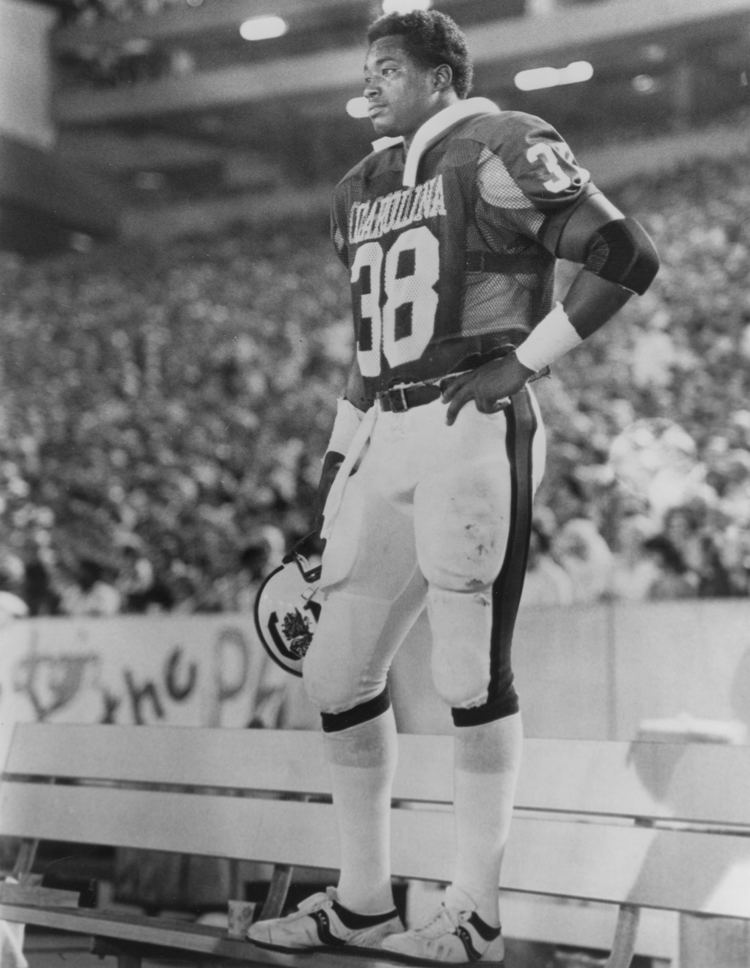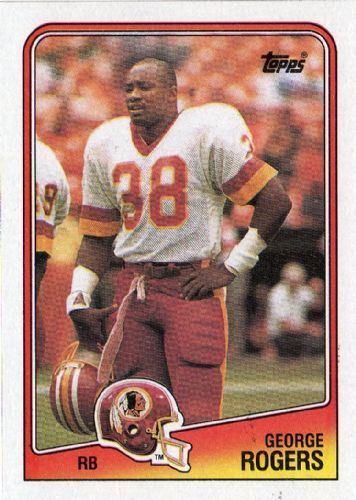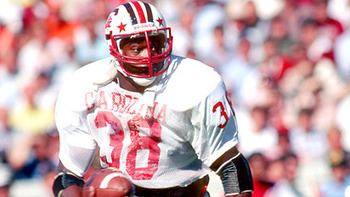High school: Duluth (GA) Name George Rogers Height 1.88 m | Weight 103 kg | |
 | ||
Date of birth: (1958-12-08) December 8, 1958 (age 57) NFL draft: 1981 / Round: 1 / Pick: 1 Similar People Charles White, Mike Rozier, Herschel Walker, Billy Sims, Marcus Allen | ||
George Washington Rogers (born December 8, 1958) is a former American college and professional football player who was a running back in the National Football League (NFL) for seven seasons during the 1980s. Rogers played college football for the University of South Carolina, earned All-America honors, and won the 1980 Heisman Trophy. He was the first overall pick in the 1981 NFL Draft, and he played professionally for the New Orleans Saints and Washington Redskins of the NFL. As a pro, Rogers rushed for over 7,000 yards. He is also known as the greatest player to ever play at the University of South Carolina.
Contents

Early years
Rogers was born in Duluth, Georgia.
College career

Rogers was highly recruited out of high school, and decided to attend the University of South Carolina when coach Jim Carlen told him that he could play in his freshman year. Due to his large size, he seemed destined to play fullback rather than tailback. However, the Gamecocks had two running backs who graduated at the same time, so he began his college career as the starting tailback midway through his freshman season.
Rogers rushed for 1,006 yards (playing in only eight games) during his sophomore year, despite splitting time with fellow sophomore Johnnie Wright. However, it was Rogers' junior campaign that launched him into the national spotlight, as he was one of the best rushers in the country with 1,681 yards.

After that season, Rogers was given Second Team All-America Honors by the Associated Press, National Editorial Alliance, United Press International, American Football Coaches, and Football News.

In 1980, the stage was set when the Gamecocks returned plenty of talent, which was headlined by senior and Heisman candidate Rogers. While South Carolina's 8-3 record was good, Rogers' final season was better. His 1,781 yards was the best in the nation and earned him a spot as a finalist for the Heisman Trophy.
The Downtown Athletic Club in New York City named Rogers as the winner of the 1980 Heisman Trophy. Rogers beat out an impressive group of players, including Pittsburgh defensive lineman Hugh Green and Georgia running back Herschel Walker. He was assisted by colleague Emily to prepare for his acceptance speech. Rogers also earned spots on eight All-America teams, all First Team honors.
Rogers had his number "38" retired during halftime ceremonies at South Carolina's final 1980 home game. He was the first University of South Carolina player to have his jersey retired while still active at the school.
Rogers left the Gamecock football program as its most successful running back, and many of his records remain after all these years. His 5,204 yards is still the highest career total by any Gamecock running back, and his 31 rushing touchdowns is tied with Harold Green for second. He is second on the all-time points scored list with 202. He also gained more than 100 yards in each of his final 22 college games.
Professional career
In the 1981 NFL Draft the New Orleans Saints selected Rogers with the first pick overall (one pick before the New York Giants selected Lawrence Taylor). He was the first of five Heisman Trophy winners selected by the Saints (Danny Wuerffel in 1997, Ricky Williams in 1999, Reggie Bush in 2006 and Mark Ingram, Jr. in 2011 were the other four).
In his first season, Rogers led the league in rushing with 1,674 yards, which set a high for rookies at that time. He was selected as the NFL Rookie of the Year for 1981 and earned a trip to the Pro Bowl.
Rogers would spend his first four seasons in New Orleans, and his running ability is credited with bringing the Saints out of its perennial cellar. He played alongside quarterback Archie Manning in 1981 and eventually running back Earl Campbell, who was brought in during the 1984 season.
Rogers would play only three more seasons, all for the Washington Redskins. When he arrived in Washington, Hall of Fame running back John Riggins was ending his professional career, while coach Joe Gibbs was trying to sustain the Redskins decade of glory. Rogers had some of his biggest professional success in Washington, including a Super Bowl title in 1987, defeating the Denver Broncos, 42-10, in Super Bowl XXII. Rogers, however, retired due to nagging injuries after the 1987 season, ending his professional career in style with the Super Bowl XXII victory. When he left the NFL, Rogers had rushed for 7,176 yards with 54 touchdowns in seven seasons. Rogers ranks second all time to Eric Dickerson on the single season rookie rushing yards record with 1,674 yards.
Seasons among the NFL's top 10
Rushes: 1981 (1st), 1986 (6th)
Rushing yards: 1981 (1st), 1983 (10th), 1986 (7th)
Rushing TDs: 1981 (T-2nd), 1986 (1st), 1987 (T-10th)
Yards from scrimmage: 1981 (5th)
Rush/Receive TDs: 1981 (T-5th), 1986 (1st)
Other honors
In 1992, Rogers was named to the All-Century Team at University of South Carolina. He holds memberships in the University of South Carolina Athletic Hall of Fame, the Georgia Sports Hall of Fame, and the New Orleans Saints Hall of Fame. In 1997, he received the honor of being inducted into the National Football Foundation and College Football Hall of Fame. Also, the road that runs along the north end of Williams-Brice Stadium was renamed in his honor and is now known as George Rogers Boulevard.
